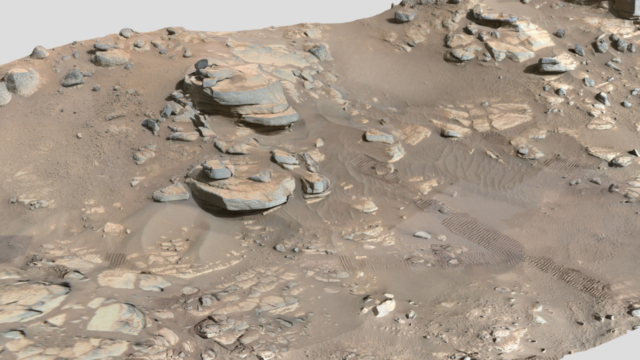
2024-01-11
Mars in 3D! Part 2: Brac outcrop in Séítah
By Christian Tate, Roland K. Aristide, and the Mastcam-Z Team
The Mastcam-Z cameras aboard the Mars 2020 Perseverance Rover play a crucial role in interpreting the three-dimensionality of Mars’ surface. This instrument takes stereo images that – when processed with photogrammetry techniques – can build high-fidelity 3D models. This is the second blog of the Mars in 3D! series, in which we take a close look at the second sampling location: the Brac outcrop in the Séítah region, Jezero Crater, Mars. The future Mars Sample Return (MSR) will return one of the two samples taken at Brac!
Exploring the Séítah region
After traversing sand ripples and rough terrain, Perseverance entered the South Séítah region in Sol 201. This is an olivine-rich igneous formation with sand and gravel between the outcrops. Fun fact, “séítah” means “amongst the sand” in Navajo, and there is a great deal of sand in Séítah. As we explore the models below, you will gain a more visual understanding of this location. See this blog post or this Science article for more details about Séítah’s geology.
Séítah is located along the crater floor, an area of particular scientific interest for its exposed rock layers, providing a geological history of the region. According to Erin Gibbons, a Mars 2020 collaborator at McGill University, “by studying the directions that the layers tilted, we determined that the rocks of Séítah are likely the most ancient rocks exposed in all of Jezero crater. Séítah, therefore, represents the beginning of the accessible geologic record and offers a once-in-a-mission opportunity to explore the full breadth of landscape evolution.” The models below show the Brac outcrop at two scales. Can you see where Models 2 and 3 fit in the broader context of Model 1?
Model 1: This interactive model is of the area of the Séítah region containing the Caille, Brac, and Cheiron sites. Made from high-resolution images taken on Sol 236-265 with the Mastcam-Zs, Navcams, and Hazcams on the Perseverance Rover. Photo Credit: NASA/JPL-Caltech/ASU/MSSS/Cornell.
Model 2: This interactive model is of the Broc sampling site and Caille outcrop in Séítah before collecting samples. Made from high-resolution photography taken on Sol 236-250 with the Mastcam-Zs, Navcams, and Hazcams on the Perseverance Rover. Photo Credit: NASA/JPL-Caltech/ASU/MSSS/Cornell.
Model 3: The interactive model above depicts the Broc sampling site in Séítah made from high-resolution photography taken on Sol 236-250 with the Mastcam-Zs, Navcams, and Hazcams on the Perseverance Rover. Photo Credit: NASA/JPL-Caltech/ASU/MSSS/Cornell.
Creating an abrasion patch
Upon arriving at its outcrop of interest, Perseverance drilled a small circular outer layer from Brac in order to expose its raw inner content. This abraded surface is free from contamination by the rest of the Martian environment, which is necessary for Perseverance’s arm-held proximity instruments. Mastcam-Z images of this abrasion patch provide a reference to compare with other sample locations. Examine the abrasion created from Brac using the interactive models below, and notice how characteristics such as texture and colors differ from the outcrop’s surface.
Model 4: This interactive model is of the Dourbes abrasion target taken from high-resolution WATSON images on Sol 253 and other images from Sol 249-255 with the Mastcam-Z on the Perseverance Rover. Photo Credit: NASA/JPL-Caltech/ASU/MSSS/Cornell.
Coring the Brac samples
Upon analyzing the abrasion, Perseverance then cored the Brac outcrop to collect the “Salette” and “Coulettes” samples on sol 271, the third and fourth rock samples the rover has collected, and the fifth and sixth samples overall. Thanks to Mastcam-Z’s spectroscopic powers combined with Perseverance’s x-ray fluorescence data, two methods that use light to break down an object’s composition, scientists were then able to identify Brac as being primarily composed of igneous rock: a particular type of rock believed to have formed when Olivine minerals settled in a layer of thick magma. After forming they were then modified by coming in contact with liquid water. Not only that, but scientists could even identify the presence of organic matter within these samples! These findings are consistent with previous analyses of Martian meteorites found here on Earth.
Model 5: This is an interactive model of the Coulettes sample and protective case lying on the surface of Mars at the Three Forks Sample Depot. Photo Credit: NASA/JPL-Caltech/ASU/MSSS/Cornell.
Returning a sample of Brac
The Mars 2020 Missions have come a long way since Perseverance’s visit to the Brac outcrop, but the journey is far from over! On sol 693, the rover carefully dropped off the Coulettes sample at the Three Forks sample depot area where it currently lays alongside nine other sample tubes awaiting retrieval as a part of the upcoming Mars Sample Return Mission. Although these samples aren’t expected to arrive at their new home on Earth until the early 2030s, these 3D models help us visualize the environment they come from and slowly unravel the secrets they hold.
[NOTE: This is the second post in a series of blog entries by Mastcam-Z’s Photogrammetry Subteam at Cornell University. The first entry can be found here. The Cornell team is specializing in the development of Digital Terrain Models (DTMs) of the Martian surface in Jezero Crater based on Mastcam-Z stereo images. These DTMs are being created for both scientific analysis as well as public outreach/educational use.]